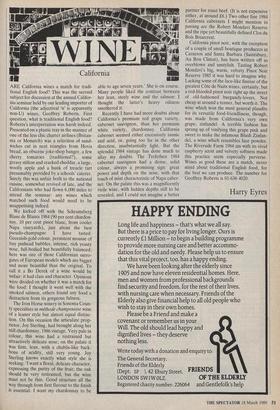California
ARE California wines a match for tradi- tional English food? This was the second subject for discussion at the annual Califor- nia seminar held by our leading importer of California (the adjectival 'n' is apparently non-U) wines, Geoffrey Roberts. First question, what is traditional English food? Roberts's interpretation was harsh indeed. Presented on a plastic tray in the manner of one of the less chic charter airlines (Britan- nia or Monarch) was a selection of sand- wiches cut in neat triangles from Hovis bread, an obscene joke-shop banger, a few cherry tomatoes (traditional?), some greasy stilton and cracked cheddar, a large, woolly apple and a hunk of treacle tart presumably provided by a schools' caterer. Surely this was unfair both to the national cuisine, somewhat revived of late, and the Californians who had flown 6,000 miles to attend the seminar: any wines which matched such food would need to be unappetising indeed.
We kicked off with the Schramsberg Blanc de Blanes 1984 (90 per cent chardon- nay, 10 per cent pinot blanc, from cooler Napa vineyards),, just about the best pseudo-champagne I. have tasted. Greenish-gold colour, persistent mousse of tiny pinhead bubbles, intense, rich yeasty nose, full-bodied but beautifully balanced; here was one of those Californian surro- gates of European models which are bigger and more beautiful than the original. To call it a Bo Derek of a wine would be unfair: it had class and character. Opinions were divided on whether it was a match for the food: I thought it went well with the smoked salmon, others found any food a distraction from its gorgeous fulness.
The Iron Horse winery in Sonoma Coun- ty specialises in methode champenoise wine of a leaner style but almost equal distinc- tion. On this occasion the articulate prop- rietor, Joy Sterling, had brought along her still chardonnay, 1986 vintage. Very pale in colour, this wine had a restrained but attractively delicate nose; on the palate it was firm, lean, with a chablis-like back- bone of acidity, still very young. Joy Sterling knows exactly what style she is seeking: 'I want a floral, delicate character, expressing the purity of the fruit; the oak should be very restrained, but the wine must not be thin. Good structure all the way through from first flavour to the finish is essential. I want my chardonnay to be able to age seven years.' She is on course. Many people liked the contrast between her lean, steely wine and the salmon: I thought the latter's heavy oiliness smothered it.
Recently I have had more doubts about California's premium red grape variety, cabernet sauvignon, than her premium white, variety, chardonnay. California cabernet seemed either excessively tannic and acid, or, going too far in the other direction, insubstantially light. But the splendid 1984 vintage has done much to allay my doubts. The Trefethen 1984 cabernet sauvignon had a dense, solid colour, always a promising sign: great power and depth on the nose, with that touch of mint characteristic of Napa caber- net. On the palate this was a magnificently virile wine, with hidden depths still to be revealed, and I could not imagine a better partner for roast beef. (It is not expensive either, at around £8.) Two other fine 1984 California cabernets I might mention in passing are the Robert Mondavi Reserve and the ripe yet beautifully defined Clos du Bois Briarcrest.
California pinot noir, with the exception of a couple of small boutique producers in Carneros and Santa Barbara (Saintsbury, Au Bon Climat), has been written off as overblown and unstylish. Tasting Robert Mondavi's big, warm, velvety Pinot Noir Reserve 1985 it was hard to imagine why. Lacking some of the lace-like finesse of the greatest Cote de Nuits wines, certainly, but a red-blooded pinot noir right up the street of old-fashioned burgundy-lovers. Not cheap at around a tenner, but worth it. The wine which won the most general plaudits for its versatile food-friendliness, though, was made from California's very own grape, zinfandel. A terrible fashion has sprung up of vinifying this grape pink and sweet to make the infamous Blush Zinfan- del, a wine which resembles face powder. The Riverside Farm 1984 zin with its vivid raspberry scent and velvety softness made this practice seem especially perverse. Wines as good these are a match, never mind about traditional English food, for the best we can produce. The number for Geoffrey Roberts is 01-636 4020.
Harry Eyres


























































 Previous page
Previous page